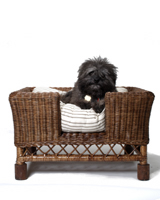| |

|
|
Keeping Children Safe
Most dog related injuries happen to children, in their own home or the home of a relative or a friend and by a dog that they know.
When a dog is around, small children should be supervised at all times because:
- they can unwittingly provoke an attack, for example by trying to take a bone away from a dog, hugging or kissing it
- dogs may get excited by games being played and jump on or chase a child
- dogs may try to dominate a child because of a child’s small size.
Children should be taught basic safety habits around dogs, with parents and caregivers showing the way.
Be extra careful with toddlers
Toddlers are especially vulnerable because of their small size, and lack of understanding of risks and verbal instructions. Toddlers should be closely supervised at all times around dogs.
A toddler should not be allowed to:
- be around dogs, including puppies, without adult supervision
- put their face down to a dog’s face, hug or kiss it
- play with a dog’s, food, feeding bowl, toys or bedding
- wander into neighbouring properties where there may be dogs.
Be very careful with school age children
School age children may put themselves at risk without thinking. They might be quite unrealistic about dogs and not appreciate the risk of being bitten, even by the family pet. For this reason, parents and caregivers should supervise children and dogs when they are together, and correct any unsafe behaviour.
School age children should be taught basic dog safety at a pace they can handle including:
- how to play with and around dogs
- what to do around dogs and how dogs react in certain situations
- what to do if they are worried about a dog
- asking the owner if they want to pat a dog
Our Tips For Kids are aimed broadly at 5 – 12 year olds.
Be a good role model
Children learn by example – so be a good role model by setting good dog safety rules with your family and following them yourself.
What should I do if, despite all precautions, a child is bitten or attacked?
There is a guide to first aid on the St John Ambulance website.
This is what the St John website says about first aid for a cat or dog bite:
Domestic animal bites usually cause an infected wound. Although the wound may be small, medical advice is recommended, and antibiotics are often prescribed and a protective tetanus injection given.
How you can help
1. Control any bleeding
- If the wound is bleeding apply a firm pad.
- Seek urgent medical advice and treatment.
2. Clean a minor wound thoroughly
- Use warm soapy water or a saline solution to clean the wound.
- Apply a protective dressing and seek medical advice.
More detailed information for medical professionals is available on the Starship Hospital website:
What should I do about any possible psychological and emotional issues after a dog attack on a child?
- If a child is attacked, your General Practitioner will be able to make an initial assessment about what services might be needed, if any. ACC (Accident Compensation Corporation) may also be able to provide assistance if a child has suffered a mental injury as a result of a dog bite.
- Tell the child’s school or pre-school so the experience can be taken into account.
- Talk with your child about their experiences with dogs.
- Encourage any child who has a bad experience to continue to follow the advice on staying safe around dogs. This advice includes remaining calm around dogs and not running away.
|

